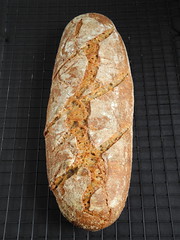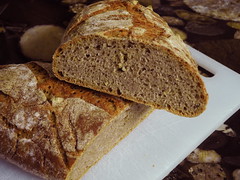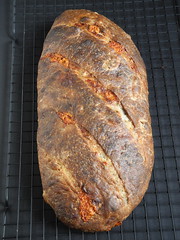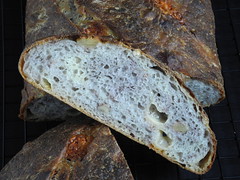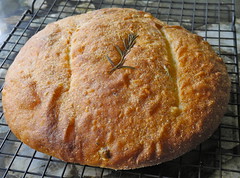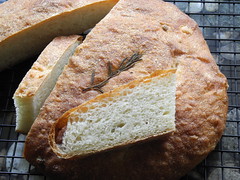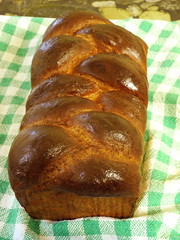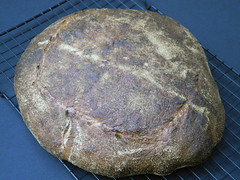 Next up in the BBA Challenge list was another entry in the sourdough section, the Poilâne-Style Miche. This bread is in the cover photo--a huge round of very dark-brown bread. I did my usual half-recipe, so my round loaf was merely large, not huge. After seeing the size of my loaf, I don't think my baking stone could handle the full-sized miche. To deconstruct the recipe title: Poilâne is Lionel Poilâne, a famed French baker. Miche, according to wikipedia, is the word for a large round loaf. The recipe uses a sourdough starter and long fermentation times to build flavor in the bread, and calls for a sifted medium-grind whole-wheat flour to replicate Poilâne's flour. I went with the suggested substitution of half whole-wheat, half bread flour.
Next up in the BBA Challenge list was another entry in the sourdough section, the Poilâne-Style Miche. This bread is in the cover photo--a huge round of very dark-brown bread. I did my usual half-recipe, so my round loaf was merely large, not huge. After seeing the size of my loaf, I don't think my baking stone could handle the full-sized miche. To deconstruct the recipe title: Poilâne is Lionel Poilâne, a famed French baker. Miche, according to wikipedia, is the word for a large round loaf. The recipe uses a sourdough starter and long fermentation times to build flavor in the bread, and calls for a sifted medium-grind whole-wheat flour to replicate Poilâne's flour. I went with the suggested substitution of half whole-wheat, half bread flour. The mixing of the miche was much like other sourdoughs: it started with making a firm starter the night before using a refreshed barm, and letting that rise for 6 hours. The day of, the starter came out of the fridge to warm up, then was mixed with flour, salt, and water to make the dough. Reinhart warns that this bread is too large for machine mixing, but my half recipe worked well in the KitchenAid. I added the maximum amount of water (11 ounces), then added almost another ounce during the kneading--that was almost too much, and my dough was probably beyond 'tacky' to 'sticky'. With generous coatings of Pam, I was able to keep it from sticking too much.
The first rise was in a plastic dough bucket, and I let it go for a full 4 hours. Then I shaped the dough into a boule, trying hard to get a good taut skin without degassing the dough more than necessary. The boule then went into a mixing bowl (a rather shallow one) lined with a heavy pastry cloth, and rose another 2-1/2 hours. I got the risen loaf turned out onto my peel without too much difficulty, but found my pastry cloth had stuck some despite the spray of Pam and a dusting of flour--I got a few little folds in the top of the loaf while removing the cloth. Then it was on to the slashing of the loaf, where again my lame snagged and produced an irregular cut, then I slid the loaf onto my baking stone, poured the 2 cups of hot water into my steam pan, and closed the oven. Unlike other hearth loafs, this one doesn't call for spraying water on the sides of the oven in the first few minutes, so the loaf bakes undisturbed until it is rotated for an even baking.
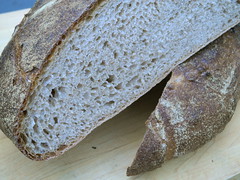 I should haver reduced the first oven period from the 25 minutes for the full-sized miche, as mine was quite dark when I rotated the loaf and turned the oven down. I covered the loaf with foil and gave it another 10 minutes (the full loaf goes for 30-40), and the internal temperature was at 203.
I should haver reduced the first oven period from the 25 minutes for the full-sized miche, as mine was quite dark when I rotated the loaf and turned the oven down. I covered the loaf with foil and gave it another 10 minutes (the full loaf goes for 30-40), and the internal temperature was at 203.The bread got sliced while still a little warm (both nieces wanted some for dinner), but wasn't gummy. It has a nice even and chewy texture, maybe a little dense, and a good crust. I had some with herbs and oil, and a little more with butter, both of which complemented it well. The bread is supposed to keep well, too, so I look forward to trying it on day 2 or 3.
